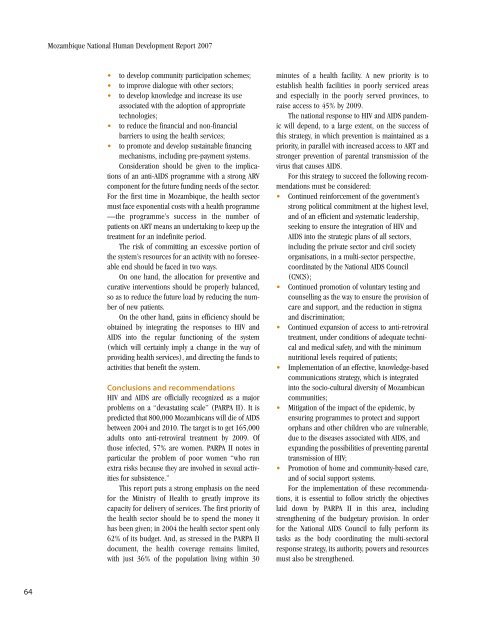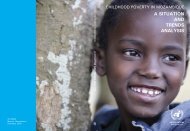English language version - Human Development Reports - United ...
English language version - Human Development Reports - United ...
English language version - Human Development Reports - United ...
- No tags were found...
You also want an ePaper? Increase the reach of your titles
YUMPU automatically turns print PDFs into web optimized ePapers that Google loves.
Mozambique National <strong>Human</strong> <strong>Development</strong> Report 2007• to develop community participation schemes;• to improve dialogue with other sectors;• to develop knowledge and increase its useassociated with the adoption of appropriatetechnologies;• to reduce the financial and non-financialbarriers to using the health services;• to promote and develop sustainable financingmechanisms, including pre-payment systems.Consideration should be given to the implicationsof an anti-AIDS programme with a strong ARVcomponent for the future funding needs of the sector.For the first time in Mozambique, the health sectormust face exponential costs with a health programme—the programme’s success in the number ofpatients on ART means an undertaking to keep up thetreatment for an indefinite period.The risk of committing an excessive portion ofthe system’s resources for an activity with no foreseeableend should be faced in two ways.On one hand, the allocation for preventive andcurative interventions should be properly balanced,so as to reduce the future load by reducing the numberof new patients.On the other hand, gains in efficiency should beobtained by integrating the responses to HIV andAIDS into the regular functioning of the system(which will certainly imply a change in the way ofproviding health services), and directing the funds toactivities that benefit the system.Conclusions and recommendationsHIV and AIDS are officially recognized as a majorproblems on a “devastating scale” (PARPA II). It ispredicted that 800,000 Mozambicans will die of AIDSbetween 2004 and 2010. The target is to get 165,000adults onto anti-retroviral treatment by 2009. Ofthose infected, 57% are women. PARPA II notes inparticular the problem of poor women “who runextra risks because they are involved in sexual activitiesfor subsistence.”This report puts a strong emphasis on the needfor the Ministry of Health to greatly improve itscapacity for delivery of services. The first priority ofthe health sector should be to spend the money ithas been given; in 2004 the health sector spent only62% of its budget. And, as stressed in the PARPA IIdocument, the health coverage remains limited,with just 36% of the population living within 30minutes of a health facility. A new priority is toestablish health facilities in poorly serviced areasand especially in the poorly served provinces, toraise access to 45% by 2009.The national response to HIV and AIDS pandemicwill depend, to a large extent, on the success ofthis strategy, in which prevention is maintained as apriority, in parallel with increased access to ART andstronger prevention of parental transmission of thevirus that causes AIDS.For this strategy to succeed the following recommendationsmust be considered:• Continued reinforcement of the government’sstrong political commitment at the highest level,and of an efficient and systematic leadership,seeking to ensure the integration of HIV andAIDS into the strategic plans of all sectors,including the private sector and civil societyorganisations, in a multi-sector perspective,coordinated by the National AIDS Council(CNCS);• Continued promotion of voluntary testing andcounselling as the way to ensure the provision ofcare and support, and the reduction in stigmaand discrimination;• Continued expansion of access to anti-retroviraltreatment, under conditions of adequate technicaland medical safety, and with the minimumnutritional levels required of patients;• Implementation of an effective, knowledge-basedcommunications strategy, which is integratedinto the socio-cultural diversity of Mozambicancommunities;• Mitigation of the impact of the epidemic, byensuring programmes to protect and supportorphans and other children who are vulnerable,due to the diseases associated with AIDS, andexpanding the possibilities of preventing parentaltransmission of HIV;• Promotion of home and community-based care,and of social support systems.For the implementation of these recommendations,it is essential to follow strictly the objectiveslaid down by PARPA II in this area, includingstrengthening of the budgetary provision. In orderfor the National AIDS Council to fully perform itstasks as the body coordinating the multi-sectoralresponse strategy, its authority, powers and resourcesmust also be strengthened.64
















